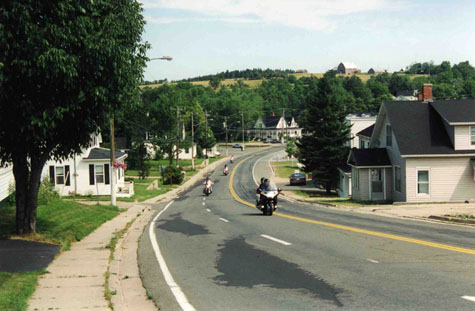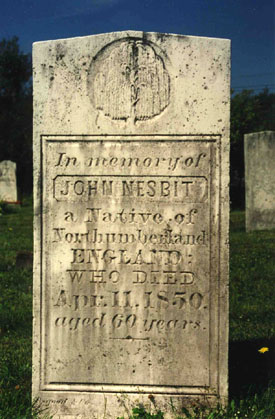

Elliott, Bruce, 2004-2005: Emigrant Recruitment by the New Brunswick Land
Company: The Pioneer Settlers of Stanley and Harvey.********************************************************************************
The immigrants, with suitable instruction, commenced work in August and by winter had cleared about an acre and a half on each lot and constructed 21 log houses.(92) They nonetheless spent the winter of 1837-38 in Fredericton, "sheltered in the new Hospital".(93) Teamsters employed by the government conveyed "6 Loads of Emigrants & Provisions" to Harvey the ensuing April, so that they could plant their crops, and they were provisioned there through the spring. Unfortunately the season was inclement and the crops failed almost entirely. They continued to be provisioned by the Legislature, and the costs vastly exceeded the £200 voted, though some of the expenses were met from payments made for the settlers' work on the road. By the end of the first year there were 23 families on the land, consisting of 113 individuals. Two hundred acres had been cleared and 160 readied for planting.(94) The Commissioners appointed by the Legislature to oversee their location concluded, "For industry, sobriety, and perseverance No men can surpass them, while they only want an opportunity to introduce the most approved Systems of agriculture as now pursued in England." (95) By 1840 the acreage in crop had increased to 184, and by 1843 to 291½.(96)
Medium sized pop up image
700 X 458, 72 dpi, 109 kFull sized pop up image
2364 X 1547, 180 dpi, 929 kClose-up of W.W.E Smith Store, October, 2004. Source: Tim Patterson.
Medium sized pop up image
700 X 297, 72 dpi, 85 kFull sized pop up image
2992 X 1268, 180 dpi, 2433 k
The settlers pursued a variety of strategies for making the best they could of their lands. John Cockburn by 1851 kept "a comfortable little inn" on the St Andrew's road, and "had several sons grown up, all of whom but one had already left him, and settled on farms of their own". John Thompson, the schoolmaster, was "not overpaid, nor above the necessity of mending his own clothes, and making shoes for his family." The nephew and namesake who had accompanied the Thompsons to New Brunswick had left the settlement. William Grieve, a shepherd from Whittingham, had arrived with only 7s 6d in his pocket, and had chosen not to begin work immediately on his lot at Harvey. He had hired himself out as a farm servant to Colonel Shore at Fredericton for £30 a year, and found work for his children as well. He paid his neighbours to clear his land for him, bringing some much needed cash into the settlement. After seven years the family took up residence, building a frame house immediately, "without the previous erection of a log-house". By 1850 he owned 700 acres and had clearings of 20 acres on each of three or four lots, "intended for his several sons". Grieve attributed his family's success to money "saved ... off their backs and their belly" and observed, "Though I might not have more comfort myself, there is the satisfaction of providing well for my family." (97)
Gravestone at Harvey Settlement Cemetery "In memory of JOHN NESBITT, a Native of Northumberland, ENGLAND: WHO DIED Apr. 11. 1850. aged 60 years", one of the Cornelius party of 1837.
Source : Bruce S. Elliott, 2002
Medium sized pop up image
700 X 1066, 72 dpi, 235 k
Full sized pop up image
1547 X 2356, 400 dpi 1083 k
_________________________________________________________________________
(94) PANB, RS 24, 1839 re5, Accounts of Commissioners for English Emigrants, 24 January 1839, and Report of the Commissioners for locating the Northumberland Emigrants, 2 March 1839.
(96) Returns of Harvey Settlement, 1840, from Journal of House of Assembly , 1841, Appendices, p. cli, and 1843 from NA, MG9 A1, vol. 123, p. 89, reel M-1670.
(97) James F.W. Johnston, Notes on North America: Agricultural, Economical, and Social (Edinburgh and London: William Blackwood and Sons, 1851), Vol. II, 168-78; CIHM no. 35750. My thanks to Tim Patterson for this reference.


